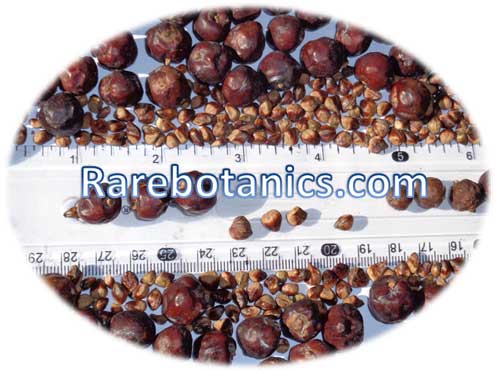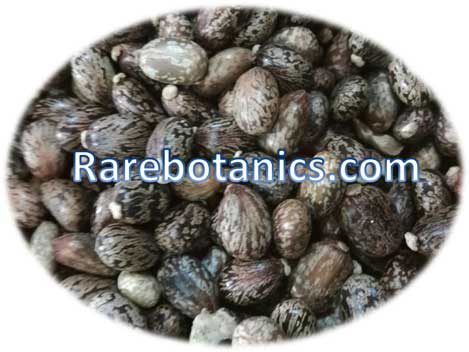Juniperus communis seeds and berries
Description
Juniperus communis (Cupressaceae) is an evergreen shrub or small tree that grows up to 9 m (29 ft.). It mostly occurs in woodland gardens, cultivated beds, sunny edges and dappled shades. It is also known as common Juniper. It is found on high altitude of 3000 m from sea level. There are two sub species of Juniper i.e. “The Dwarf Juniper”(Juniperus communis subsp. nanaWild.) and “The Tree Juniper”(Juniperus communis subsp. communis). The Dwarf Juniper is a low-growing with elongated berries and boat-shaped leaves while the Tree Juniper is a shrub with spreading in variety of growth forms, characterized by rounded berries (cones) containing seeds in them.
The Tree Juniper is the most widespread conifer in the world that is native to temperate Eurasia, North America and North of Mexico. It is a dioecious (either male or female plant, therefore both sexes must be grown if seed is available) shrub or small tree which can reach up to 10 m. It is multistemmed, decumbent with depressed crown. The branches are spread in ascending order while branchlets are terete and erect. The leaves are 1-2 cm in length, green in colour, apex is acute to obtuse in shape, elongated with abaxial glands and glaucous stomatal band in present at adaxial surface. It can be easily recognized by its triplets, wax-covered needle like leaves that form rings around young stems. The cones are globose to ovoid in shape, 6-13 mm in length, bluish black in colour, resinous to obscurely woody in appearance and contains 2 or 3 seeds each.Male plants have tiny yellow cones that shed through wind while female plants have green, berry-like, fleshy cones that becomes purple-black after 18 month on attaining maturity. Each cone comprised 3 fused scales. The seeds are hard, woody,4-5 mm in diameter and present in cones which matured approximately in 2 years.The fruit oil is, colourless or pale yellowish in colour while it turns viscous when stored for a long time. The source of pollination in this type of plant is mostly through wind and birds.
Juniper Fruits
Juniper fruits are commonly used as a household remedy, especially in the treatment of digestive, kidney and bladder disorders. They are aromatic, antiseptic, carminative, diuretic, diaphoretic and rubefacient. They are also known for the treatment of stomachic, gout, chronic arthritis, cystitis and rheumatic pain. They are soft, sweet, mealy and harvested mostly in the autumn. They are often used as vegetable pates, flavoring and stuffing. They are an important constituent of gin and can be eaten raw, cooked or used to make tea. Pregnant women and women with heavy periods are not recommended to take this fruit because it can cause abortion and high menstrual bleeding, respectively.
Juniper Oil
Juniper oil can be extracted from leaves, fruits and wood. An essential oil distilled from fruit is more superior which is used as flavoring, aromatherapy and to make fragrant perfumes. The oil is also applied externally to induce a warming effect on the skin, therefore, it is also used in the treatment of arthritic joints.This oil is also helpful to remove waste products or dead cells from skin tissues. It also helps to relieve urine retention and stimulates nervous system. Acne, psoriasis, dermatitis, eczemas and blocked pores can be also healed through this oil. The main composition of oil are α-pinene, b-pinene, α-phellandrene, α-terpinene, γ-terpinene, sabinene, limonene, myrcene etc.
The leaves and berries oil of J. co mmu nis were
characterized with a-pinene (35.35% and 10.78% ), limonene
(23.75% and 15.06%) and terpinen-4-ol (0.93% and 8.76%),
respectively. The major components characterized in the leaves
and berries essential oil of J. indica were sabinene (27.75%
and 23.17% ), terpinen-4-ol (16.11% and 23.61 %), a-pinene
(6.34% and 8.8 2%) and g-terpinene (6.05% and 6.58%),
respectively. The present study reveals
Other Uses and Benefits Of Juniper
The Juniper branches are used as an anti-dandruff shampoo. They are also used to repel insects.The tree yields a resin named “Sandarac” from incision in the trunk which is used in the production of white varnish. The stems were believed to purify the air and clean it from infection therefore, it was used as a fumigant and used to sweeten the room smell. The leaves and stems are boiled to make tea.The roasted seeds are the substitute for coffee. The bark is used as tinder, fuel and cordage. Female cones are used as flavoring in cooking. Its wood is dense, hard and highly scented but its pieces are so small to use on commercial levels. Instead, it is used in many types of decorative work. Juniper is mostly grazed by mammals in winter when there is shortening of food. It is threatened across the world due to erosion, agricultural expansion, fire, overgrazing and poor regeneration.
How to propagate Juniper?
Juniper are difficult to established and propagate through seeds. Nursery or laboratory experiments are carried out to break the seed dormancy.Seeds do not germinate immediately when sown, however required cold stratification followed by a warm period for their germination i.e. 3 months of sowing (spring) followed by 15 months (winter, summer and winter) to germinate. Seedlings emerge continuously for 5 years.Junipers can also be propagated through cuttings by maintaining good shelter, fertilization and weed control but best to propagate through seeds instead of cuttings, due to promote its genetic adaptability in population.
Requirements of Juniper for its growth:
- It prefers light sandy, medium loamy and heavy clay soils.
- It also needs well drained and can be grown in nutritional poor soil.
- It can grow on both acidic and alkaline soil.
- It prefers medium watering twice a week if there is no rainfall.
- It prefer to grow in semi shade or no shade (6 hours of direct light).
- It shows great tolerance to windy gales.
- Not good to prune from center zones.
- It can be susceptible to diseases such as, cedar apple rust, blight, bagworms, mites, aphids and other insects.
- Application of herbicide such as glyphosate is helpful to control weed production in Juniper fields.
- The plant growth can be enhanced by addition of Nitrogen (N), Phosphorus (P) and Potassium (K) fertilizers, depending upon the deficiency of soil.






Reviews
There are no reviews yet.